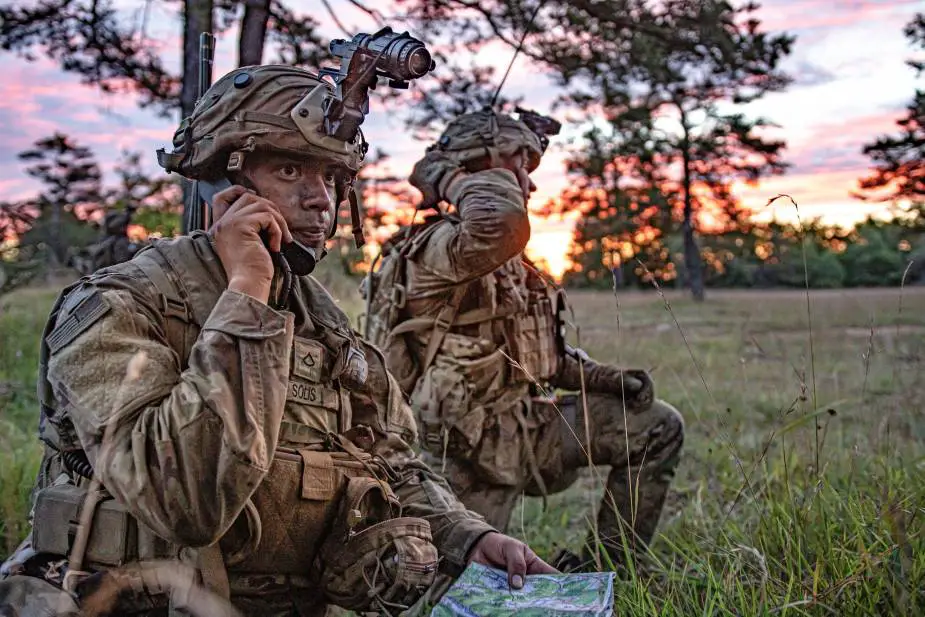US Army commander of Europe and Africa touts strategic impact of consolidation
The recent consolidation of two commands under the U.S. Army Europe and Africa Command provides flexibility in handling strategic objectives across both continents, its commander said on February 3. Sean Kimmons, Army News Service, reports.
Follow Army Recognition on Google News at this link

Soldiers assigned to 173rd Airborne Brigade conduct a map check as they approach a town for the final assault in Hohenfels Training Area, Germany, Aug. 20, 2020. The brigade falls under the new U.S. Army Europe and Africa Command after U.S. Army Europe and U.S. Army Africa consolidated in November 2020. (Picture surce: U.S. Army/Spc. Mathew Pous)
Gen. Christopher Cavoli, who previously led U.S. Army Europe before it consolidated with U.S. Army Africa, said the move presents several advantages for the Army. The general said the new command better aligns Army operations, activities and investments with the security interests of many of its allies and partners.
The command has already held a series of video teleconferences and visits with the chiefs of southern European armies to discuss security challenges closely aligned to the African continent, he said : “It gives us the opportunity to think across the entire hemisphere about security, which is very useful because in our unified command plan there may be a boundary there, but in real life there’s not a boundary,” he said during an Association of the U.S. Army Noon Report.
When the command stood up in November 2020, it broadened its aperture at the headquarters level, with personnel now attending two sequences of meetings for U.S. European Command and U.S. Africa Command : “You have to put a little more thought and energy into both problem sets,” he said, adding there is also more travel when meeting counterparts in the two regions. He plans to visit Tunisia next week to discuss, among other topics, a mission by security force assistance brigade Soldiers that helped develop the capacity of its army. “We’re very eager to dig into the Africa challenge and we think we have a lot to bring to the table,” he said.
Two regional headquarters
As part of the new structure, Cavoli envisions two headquarter elements that would oversee assets in the north and south. Once V Corps is fully mission capable, it would focus on the operational and tactical-level functions north of the Alps. Those include Operation Atlantic Resolve, which exercises rotational forces in support of a deterrence posture, as well as units like the 2nd Cavalry Regiment, 12th Combat Aviation Brigade and 41st Field Artillery Brigade.
U.S. Army Southern European Task Force, Africa, which was previously USARAF, will concentrate on all Army operations and assets in Africa and Italy, where the 173rd Airborne Brigade is located. “I’ll have two headquarters looking two different directions, which will give me the opportunity to work closer with [NATO] and with USEUCOM and USAFRICOM,” Cavoli said.
Following the Cold War, the U.S. Army drastically reduced its presence in the European theater by moving divisions and then inactivating V Corps in 2013. “In a sense we de-echeloned a theater and echelons are really necessary for large-scale operations,” he said, referring to great power competition with near-peer adversaries, which is part of the National Defense Strategy. “In a large-scale fight, headquarters are weapons systems.” Without those echelons, USAREUR lacked the ability to handle the specific affairs of subordinate units, such as its brigades, he said.
There was also a cost for USAREUR not being able to spend enough time on strategic planning and working with the Department of the Army to develop and refine fighting techniques and plans in Europe, he added. “V Corps is huge, because it reintroduces an echelon that will allow us to focus at the appropriate level more intensely,” he said.
Readiness in Europe, Africa
The key to great power competition is to be ready to fight and win, the general said. Last year, USAREUR held its first Defender-Europe exercise that had about 10,000 U.S. Soldiers and 13,000 pieces of equipment move into the region for training, despite it being curtailed due to COVID-19, he said.
The new command is coordinating another Defender-Europe exercise for this year, which will have fewer maneuver forces and more high-end enablers train in southeast Europe, where Romania and Bulgaria have been modernizing their armies. Cavoli noted that Romania is currently developing a NATO multinational division and is seeking to certify a multinational corps. It has also started to receive High Mobility Artillery Rocket Systems and Patriot missile systems to bolster its defense. “We plan to continue working at the high tactical, operational levels of integration of intelligence and fires during Defender 2021,” he said. “It’s a very promising exercise that were looking forward to.”
U.S. Soldiers have also been very active in the information space teaming up with allies and partners to respond to disinformation as well as broadcast the truth to intended audiences : “We do that very quickly and usually through our allies’ media organs or contacts that we have operating in the information sphere here in Europe and Africa,” he said. The efforts are part of the command’s approach in competing for access, information and influence over near-peer adversaries.
Other methods that help the Army do that include building strong relationships with allies and gaining access to their infrastructure to conduct military operations with them. “Many would be astounded to learn just how many thick, rich relationships, personally and professionally, exist between Soldiers of U.S. Army Europe and Africa and their counterparts,” he said.
With Russia and China “extremely active” in vying for influence and access in Africa, Cavoli said the command’s new structure is better suited to streamline its own operations. “We see a lot of ties between activities in Europe and in Africa when we go down there,” he said. “This again gives us the ability to see across the entire hemisphere, both continents, and not artificially divide them into two different problem sets.”


























